A traditional charcuterie board is based on either French or Italian traditions. The core of the tradition is Quality Dry-Cured Meat, pates, and cheese.
What a Traditional Charcuterie Platter Includes:
- French – French Dry Cured Meats, Offal Based Charcuterie, Salami
- Italian – Dry Cured Meat, Cheese, Preserved Vegetables, Grapes
- Modern – Open to any variations and interpretation, still cured meat and cheese are often present
When it comes to charcuterie (did you know if charcuterie is gluten-free, I wrote about this in detail), platters, cured meat like salami, and prosciutto are generally the cornerstones of most classics.
Key Points:
- Traditional Charcuterie: Rooted in French and Italian traditions, traditional charcuterie boards feature quality dry-cured meats, pâtés, and cheeses.
- Classic Components: French charcuterie includes items like Baguette, Grapes, Dijon Mustard, Rillettes de Porc, Saucisson à l’ail, Jambon de Bayonne, and Le Pâté en Croûte. Italian charcuterie features items such as Italian Bread, Prosciutto, Salami, Coppa, Pancetta, Provolone, Grilled Vegetables, and Bresaola.
- Historical Significance: French charcuterie has historical roots in utilizing all parts of the animal for preservation; traditionally, this was common in Italy and other European countries.
- Modern Interpretations: Modern charcuterie boards allow for creativity and experimentation, featuring items like Prosciutto-Wrapped Asparagus, Truffle Honey, Wild Mushroom Pâté, Burrata Cheese, Pickled Quail Eggs, and more.
- Creative Freedom: Whether sticking to classics or experimenting with new flavors and ingredients, charcuterie boards offer endless possibilities for flavor combinations, textures, and homemade creations.
There is so much variation around, it’s been expanded on in many directions and slightly warping the traditional aspects.
There is also a reason why the classics are classics – and have been successful for so long across Europe.
From what I have seen and been lucky enough to experience, I will put together some tables below so you can visualize some of these classic charcuterie (charcuterie cured meats are expensive, here I wrote why) components that stand the test of time.
The many times I have lived in Europe, I’ve been privileged to experience so much of what a classic traditional charcuterie board is.
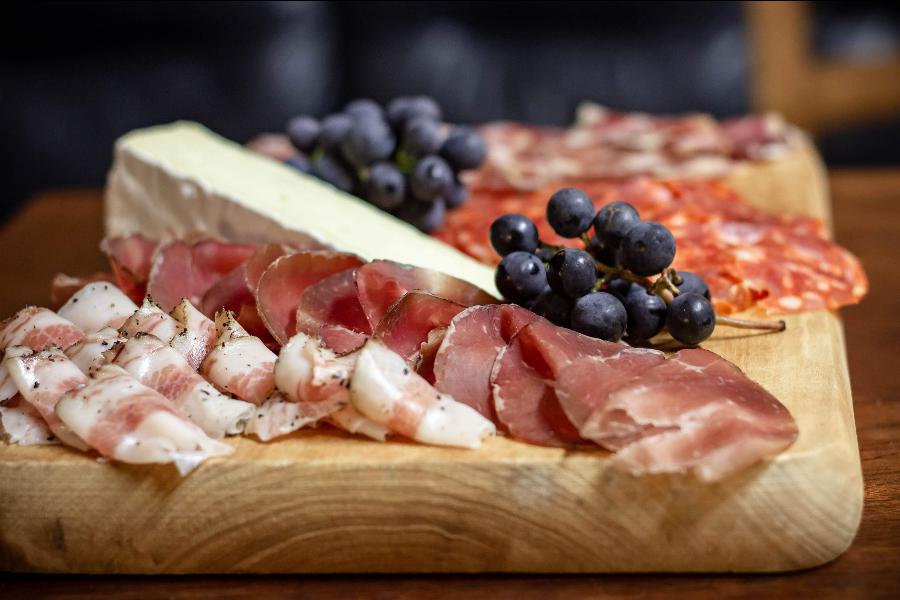
Traditional Types of Charcuterie
Traditional French Charcuterie
| Item | Description |
|---|---|
| Baguette (French Bread) | Sliced or torn into pieces, a staple for spreading pâté or making sandwiches |
| Grapes | Fresh grapes for a refreshing and sweet contrast, or Other Seasonal Fruit |
| Dijon Mustard | A classic French mustard with a sharp and slightly spicy flavor |
| Rillettes de Porc | Spreadable pork fat with spices, traditional French charcuterie |
| Le Saucisson à l’ail | Dry-cured beef, originated as Bündnerfleisch, from Switzerland |
| Viande de Grison | Dry-cured beef, originated as Bündnerfleisch, from Switzland |
| Le Pâté de Campagne | Pâté made with rustic country-style flavors |
| Le Pâté en Croûte | Duck pâté encased in pastry |
| Jambon de Bayonne | Dry Cured Ham in France, known for its delicate, slightly sweet taste |
| Le Jambon Blanc | Ham, a versatile |
| Des Rillettes | Meat preserved in fat, a savory spread |
| Des Radis | Fresh French radishes, a crunchy and peppery |
| Le Saucisson Sec | French salami, a classic charcuterie choice |
| L’Andouillette | A traditional French sausage, often made with tripe |
Oh, and then there is cheese. It’s a bit scary to start writing about French cheese – since it is a large and nearly incomprehensible topic.
Just some of the classic French charcuterie cheeses I know:
Port Salut – mild cow cheese
Brie de Meaux – known as the French ‘Queen cheese’, but supposedly enjoyed by all the citizens from peasants to royalty since the 8th Century. (link to cheese.com details)
Roquefort – blue sheep cheese, the ‘cheese of kings & popes’ – a French version of Gorgonzola
For a serious breakdown of classic French cheese, check out this site all about France & Cheese!
As you can see above, this is really pure classic French when you use the meat of different bits and pieces to create all sorts of wonderful things and cheese.
Being French, there is a lot of time spent to produce these goods – but like the Italians, there is a reason why people travel or move to France or Italy just for the food! (Good things take time, like quality dry cured meats)
Pronounced “Sharkcuutaareey” – here is a brief ‘how it’s said properly’ on YouTube by a French man.
Definition of French Charcuterie
In 15th-century France, local guilds regulated tradesmen in the food production industry in each city…..members of this guild produced a traditional range of cooked or salted and dried meats, which varied, sometimes distinctively, from region to region……charcutier prepared numerous items, including pâtés, rillettes, sausages, bacon, trotters, and head cheese (brawn). These preservation methods ensured the meats would have longer shelf lives.[2]. Charcuterie became symbolic then to lower status peasantry
Wikipedia – Charcuterie
So in the pure sense of the French word charcuterie, it’s really about making the most out of the many different aspects of a pig or animal. This is the new but old idea of the ‘head to tail‘ use of an animal (especially the pig), which is actually a very old approach. It was the common folk, that wanted to get the most of out the animal that was killed/harvested.
Most Western cultures seem to get a little squeamish when it comes to using offal, organs or intestines (Funnily enough most people don’t know the dry-cured salami bought or made are often ‘casings’ which are intestines – therefore a form of offal.
But with bits of meat that are kept in a refrigerated area, they can last a while, especially if aging whole muscles. But offal needs to be eaten fresh or cured to be preserved.
The French have always embraced the offal of animals and are renowned for pates or the famous pungent sausage – Andouille
Traditional Italian Charcuterie
| Item | Description |
|---|---|
| Italian Bread | Slices of crusty Italian bread or focaccia |
| Olive Oil | High-quality extra-virgin olive oil for dipping or drizzling on bread and vegetables |
| Marinated Olives | A variety of marinated olives |
| Prosciutto | Thinly sliced, dry-cured Italian ham with a delicate, salty flavor – 12 months to make |
| Salami | Dry-cured salami, often a minimum of 6 months to make |
| Coppa | Dry-cured pork loin is known for its tender texture and savory flavor. |
| Pancetta | Dry-cured pork belly, often used in recipes or served thinly sliced |
| Provolone | Formaggi (Cheese) – A semi-hard Italian cheese with a mild, creamy flavor |
| Grilled Vegetables | Grilled and marinated vegetables like zucchini, eggplant, and bell peppers. |
| Bresaola | Air-dried, salted beef that’s thinly (here is something I wrote about epic charcuterie dry cured meats) sliced and has a delicate, beefy taste. |
| Lonza | Dry-cured pork loin, is known for its tender texture and savory flavor. |
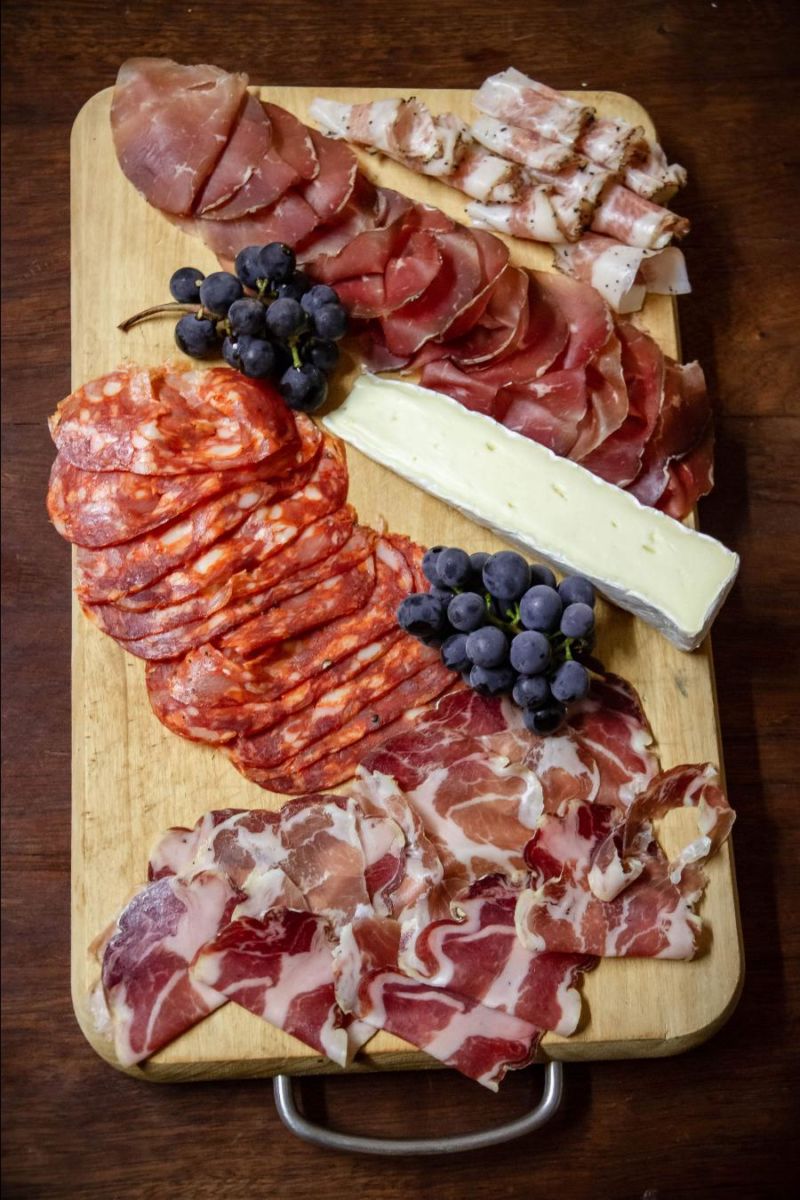
Also known as Salumi / Salami / Dry Cured Meat – charcuterie meat in the Italian interpretation encapsulates all of this.
So picante salami, cacciatore, braesola, prosciutto and pancetta – are all examples of this.
But, really, what Italian classic charcuterie boards are now are antipasto platters or boards.
I have seen salumi classics like the above over and over in Italy, delicious Italian cheese (hard, fresh, or aged—it varies), and preserved vegetables like courgette, for example.
Here is a good example I saw numerous times in different regions over a few months in Italy – https://www.gustissimo.it/ricette/antipasti-salumi/antipasto-di-salumi-all-italiana.htm
A lot of the Tuscan and Umbrian classic charcuterie board styles focused on cured meats and cheeses. Of course, it varies from region to region, but it seemed to always come back to classic Italian antipasti (plural), antipasto (singular), and Antipasta (a confusing term that doesn’t mean anything). Trust me, I wrote a whole post about this here.
Antipasto (antipasti) “before the meal” – the idea here is a plateful of goodness to stimulate the taste buds before the main Italian dishes start rolling out in abundance usually.
Definition of Italian Salumi Antipasti
Antipasto means literally “before the meal.” It is an Italian platter of cured meats, various cheeses and marinated vegetables served as a first course before the entrée. “Antipasta” is an erroneous colloquialism for “antipasto,” a mistranslation of “before the pasta.” The plural form of antipasto is “antipasti.” Unlike hors d’oeuvres or appetizers, antipasti are served before traditional Italian meals to stimulate the appetite.
eHow – Difference between Antipasto & Antipasti
Since there are so many dry-cured meats in Italy, the variations vary massively from region to region. But very often, I had classics like Lonza (pork loin), prosciutto (pork leg), and pancetta (pork belly) dry-cured meats.
An Example I had in Umbria, was a salumi/salami specialist:
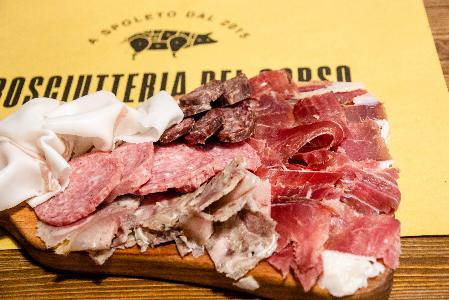
Every classic Italian charcuterie board I have had in a small town around Italy has focused heavily on dry-cured whole-muscle salami and cheeses.
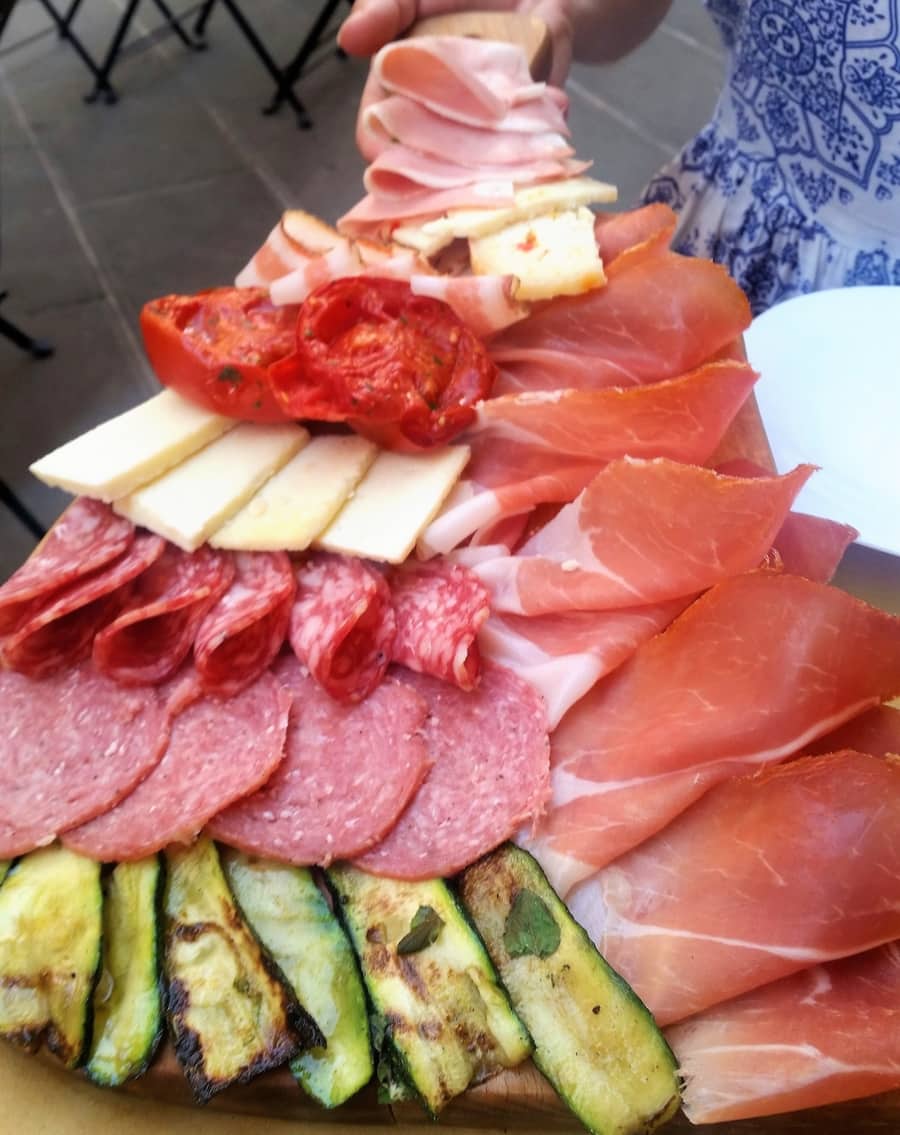
When I think about it, there is a reason why so much Italian food is perceived as classic and long-standing.
They are doing the same things they have always done, with little variation through much of their history, I’m putting this in the context of more rural places across Italy.
It’s of course very different when it comes to the melding and fusion of cities in Italy or anywhere across the world. Again I don’t think this is a bad thing, but I’m talking here more about classic charcuterie platters.
Modern Charcuterie
| Item | Description |
|---|---|
| Prosciutto-Wrapped Asparagus | Roasted asparagus spears wrapped in delicate prosciutto slices. |
| Truffle Honey | Rich and aromatic truffle-infused honey for drizzling over cheeses and meats. |
| Wild Mushroom Pâté | A creamy pâté made from a blend of wild mushrooms and herbs |
| Charcuterie-Inspired Sausage Rolls | Mini sausage rolls with flavors inspired by traditional charcuterie |
| Burrata Cheese | A creamy and decadent Italian cheese with a soft center |
| Pickled Quail Eggs | Quail eggs pickled in a flavorful brine for a unique bite-sized treat |
| Smoked Nuts | Hot or Cold Smoked with a more complex flavor |
| Whipped Feta with Herbs | A light and fluffy whipped feta cheese with fresh herbs. |
| Balsamic Pearls | Tiny balsamic vinegar pearls that burst with flavor when bitten into |
| Cured Spanish Chorizo | Dry-cured Spanish chorizo with a smoky, spicy kick |
| Quince Paste | A sweet and tangy paste made from quince fruit, perfect for pairing with cheese. |
| Salmon Roe | Delicate salmon roe for a touch of luxury and briny flavor |
| Provolone-Stuffed Cherry Peppers | Cherry peppers stuffed with provolone cheese and prosciutto |
| Seared Scallops | Scallops seared with a garlic and herb butter sauce |
| Smoked Duck Breast | Thinly sliced smoked duck breast with a rich, smoky flavor |
| Candied Ginger | Sweet and spicy candied ginger pieces for a palate cleanser |
| Mango Chutney | A tropical chutney with chunks of mango and a hint of spice |
| Saffron Aioli | A creamy aioli infused with saffron threads for a luxurious dipping sauce |
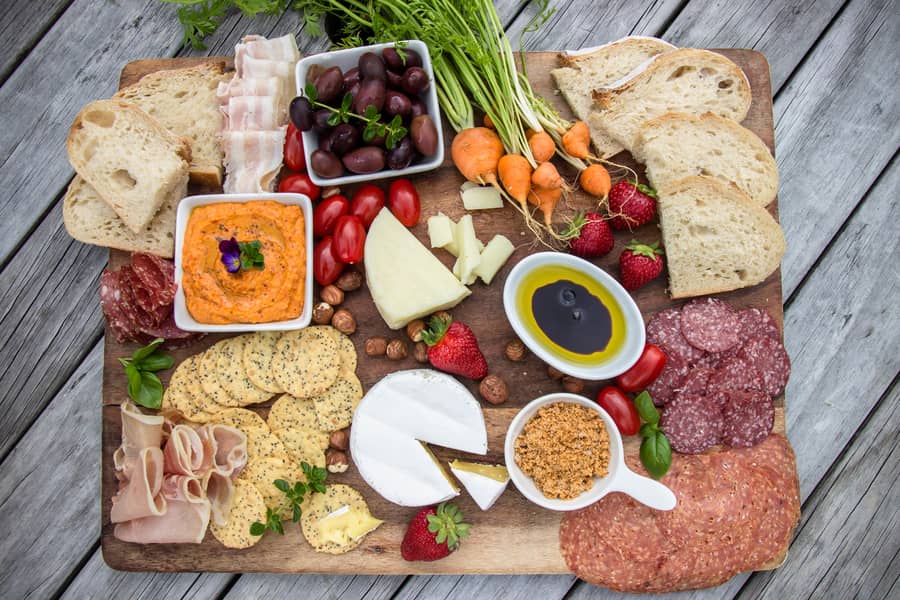
Anything can work, and there shouldn’t be any barriers to a platter of modern interpretation.
The one above has our homegrown vegetables – carrots, strawberries
homemade sourdough bread, dukkah dip, and marinated olives
So soft or hard breads and cheeses
Anything homegrown from the garden, fresh like carrots, berries, grapes, etc.
Or if I can whip up a pesto with some basil or tapenade with some olives, I like to throw one on as well.
Like anyone, I love to see creativity and people putting their twist on anything they do with food. And as they say, variety is the spice of life.
At the same time, I like to play around with more diverse charcuterie platters.
In the back of my mind, I’m always thinking about
- Contrast and flavors
- pairing of flavors
- textures
- and a focus on homemade wares
From Kids fruit ‘charcuterie boards’ to <name a country> charcuterie, and anything in between – It’s all out there.
I think it’s a varied interpretation these days since the word “charcuterie’ has been used by many restaurants to give a more sophisticated word to today’s appetizer or starter. But guys at home and many bloggers have reinterpreted it. I wrote this post just to highlight the classics and traditional since they have stood the test of time.
One of my favorite places that has taken an experimental approach to dry-cured meats and charcuterie is Smoking Goose.
Below is an example of spice-forward charcuterie, salumi and salami.
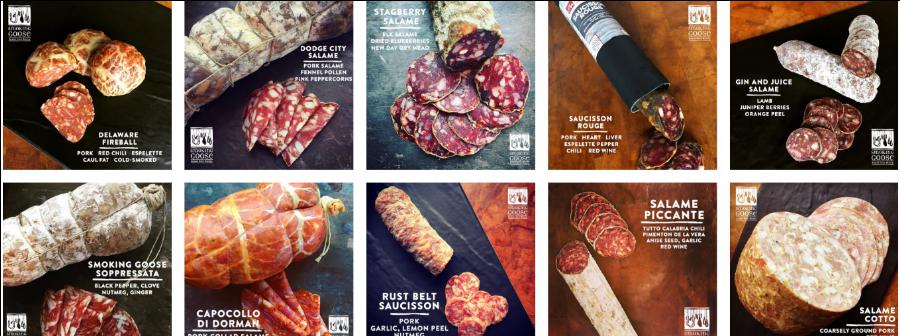
This is a good example of, for me, the creativity that you can have when it comes to making your own cured meats and flavors with a modern twist.
If you always wanted to have a go at making your own cured meat, instead of having a full curing chamber that can be redesigned from an old fridge.
For some further information and ideas see below:
Inspiration and Ideas:
https://eatcuredmeat.com/ideas-and-inspiration-a-charcuterie-board
For photos/images from some of the most stunning professional images of charcuterie boards (here is what to do with leftover charcuterie meats), I’ve put together an article below on this:
https://eatcuredmeat.com/charcuterie-board-cured-meat-essentials-images-ideas

Tom Mueller
For decades, immersed in studying, working, learning, and teaching the craft of meat curing, sharing the passion and showcasing the world of charcuterie and smoked meat. Read More
